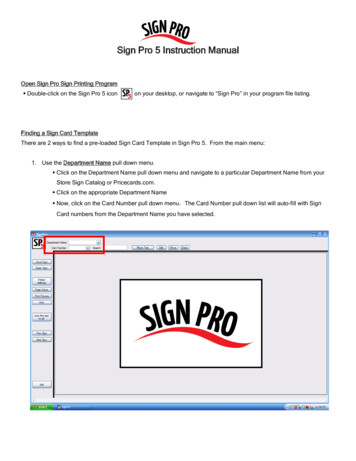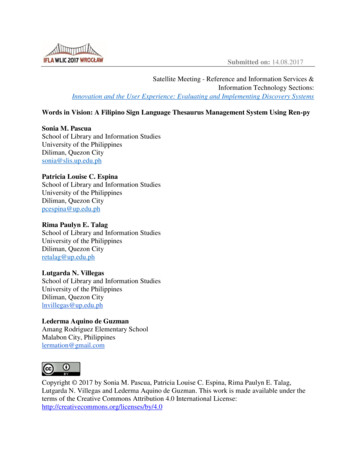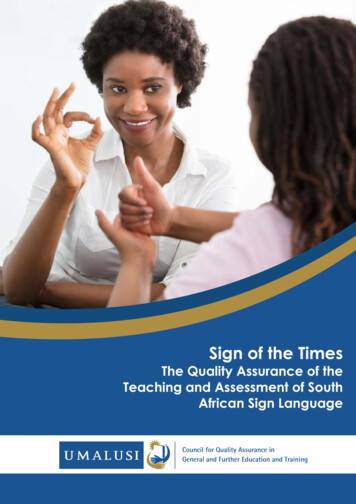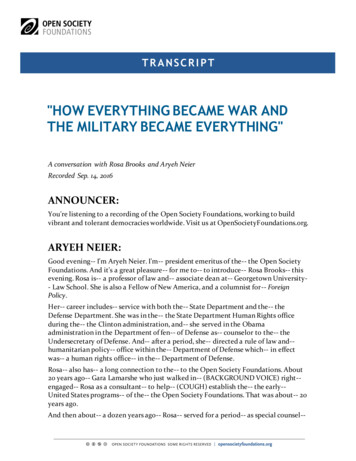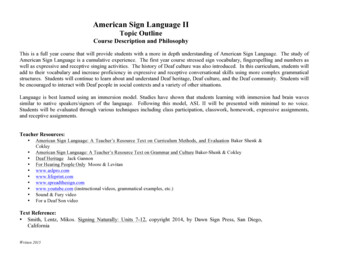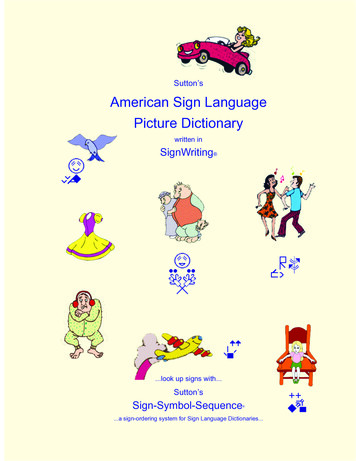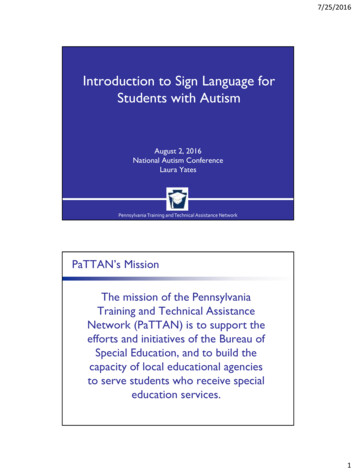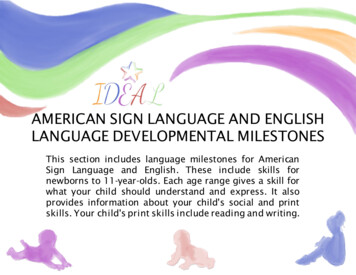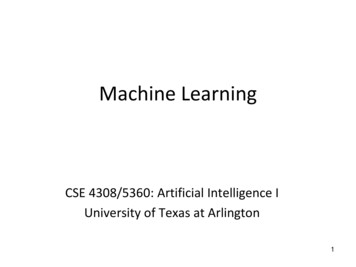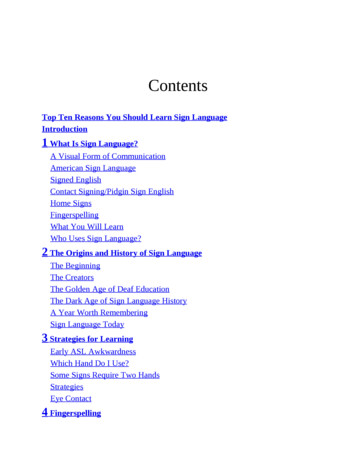
Transcription
ContentsTop Ten Reasons You Should Learn Sign LanguageIntroduction1 What Is Sign Language?A Visual Form of CommunicationAmerican Sign LanguageSigned EnglishContact Signing/Pidgin Sign EnglishHome SignsFingerspellingWhat You Will LearnWho Uses Sign Language?2 The Origins and History of Sign LanguageThe BeginningThe CreatorsThe Golden Age of Deaf EducationThe Dark Age of Sign Language HistoryA Year Worth RememberingSign Language Today3 Strategies for LearningEarly ASL AwkwardnessWhich Hand Do I Use?Some Signs Require Two HandsStrategiesEye Contact4 Fingerspelling
Situations That Call for FingerspellingTalking to YourselfBecoming an Accurate FingerspellerHand Warm-UpSpelling BeeInitialized SignsFingerspelled Loan SignsAbbreviations and States5 Get a Firm Grip on the RulesThe Big FourSigning SpaceIntonationSign EtiquettePluralsSign Order6 Questions, Questions!Two Types of QuestionsApplying Nonmanual BehaviorsAnswering QuestionsSigning Wh-WordsSign VariationsThe InterviewRhetorical Questions7 Variety Is the Spice of LifeDescribing PeopleColor My WorldDress Me UpThey’ve Got the LookThe Good and BadPronouns and Possessives8 Count 1-2-3
It’s All in the NumbersCounting to TenConversations with Letters and NumbersTackling Eleven Through NineteenCounting to NinetyBig NumbersFractionsMoneySigning Everyday Numbers9 Friends, Family, and AcquaintancesGendersFamily RelationshipsPeople You KnowThe Workplace and the ADA10 The Whole PictureA Face Is Worth a Thousand SignsLean into It with Body LanguageUsing Signs in StorytellingClassifiers, the Powerful ToolMold It, Shape It11 Ready, Set, Go!Let Your Fingers Do the WalkingSport SignsAdditional Compound SignsPlay Ball!12 Father TimePast, Present, and FutureSigning a Specific TimeGeneral TimesLearning the CalendarTime to Celebrate
13 The Great OutdoorsA Word about Service DogsThe MenagerieThe WeathermanNature’s Best14 Let the Banquet BeginDon’t Skip BreakfastLunchtime!Afternoon SnackThe Evening MealSweet Temptations15 Around and AboutHome Sweet HomeThe Telephone and the TTYComputersSchool DaysWorking Nine to Five16 What’s Up, Doc?In Sickness and in HealthThe “Broken Ear”First AidExploring the EarCaution: Fragile Ear!Cochlear Implants17 Around the WorldSign VariationsOn the Road AgainThe Three-Finger ClassifierLocation and DirectionTime for a Vacation
18 New Age of Sign LanguageBaby TalkSign Language and Early EducationHearing HealthSimplified SignsMany Faces of Sign19 Expressing Yourself with SigningSigning MusicVisual Tapestries Within the ArtsDeveloping Expressions and Body LanguageThe Art of Drama20 Further Your SkillsEveryday ChatterUsing Games to LearnTotal CommunicationCued SpeechA Quick Pop QuizVariety of CommunicationAppendix A: Quizzes and GamesAlphabet QuizTrue/False Awareness QuizLetter Form QuizSign Practice QuizQuiz AnswersSign Language GamesAppendix B: ResourcesDeaf/Sign Language ResourcesWebsitesSign Language BooksVideos and CDsAppendix C: Glossary
ACKNOWLEDGMENTSI wish to express my appreciation to the wonderful staff of Massasoit College fortheir encouragement and support in writing the second edition of TheEverything Sign Language Book. In addition, my thanks to my kind friends,Genie and the staff of Whitman Hanson Regional School District, who providedme with the faith that the first edition would actually become a reality. I sendforth sincere gratitude to my mentor, Beth, for the many years she provided mewith guidelines to writing and for her friendship. My sincerest gratitude to all ofmy past and present students from Massasoit College, the vast number of EarlyEducators, the caring parents, and the countless participants of the AmericanSign Language (ASL) courses, in-services, and workshops. These students andparticipants have provided me with endless resources to write a more concisesecond edition. My greatest appreciation is given to my friend and sister who,once again, burned the midnight oil with me, held my hand, and spent hoursevery weekend typing. Finally, I am sending my eternal, loving appreciation tomy husband for his endless support and his constant unconditional love.
Top Ten ReasonsYou Should Learn Sign Language1. To be able to communicate effectively with the Deaf and hard of hearing.2. To have fun learning a new and exciting visual language.3. To look great on a resume and to open doors for new employmentopportunities.4. To spur intellectual growth and raise IQ.5. To open new avenues for friendships and relationships.6. To improve self-confidence and enhance communication skills.7. To experience another avenue for expressing yourself artistically.8. To broaden language acquisition in the early classroom.9. To acquire the skill of nonverbal communication, body language, and facialexpressions.10. To learn a new language that can satisfy high school or college modernand foreign language requirements.
IntroductionIT’S OBVIOUS THAT you’re interested in sign language; otherwise youwouldn’t have picked up this book. But did you know that you already use anatural form of gestural language every day? Nodding your head “yes,” shakingyour head “no,” telling someone to call by holding an imaginary phone to yourear, and saying hello with a friendly wave are all natural gestures. With yournatural gestures and this book in hand, you have already given yourself awonderful head start into learning the basics of sign language.This sign language book is user-friendly. It is designed to acclimate youslowly into the various parts of sign language, while being fun at the same time.It is not meant to be a heavy textbook or a sign language dictionary. It is concisein detail and filled with fantastic sign images using real models. Each chapteroffers an easy and cumulative learning experience, and signs are presented in aprogressive pattern.While this book can be used on its own, it can also be used in conjunctionwith an American Sign Language (ASL) course and to assist in natural languageacquisition through interaction with deaf friends, relatives, and their community.This book serves as a friendly bridge between the classroom, sign dictionary,and text. It will also fill in the gray areas those new signers often find confusingor challenging. You will acquire a better understanding of the variousapplications for sign language and the population that uses this visual mode ofcommunication.Perhaps you are a person who has studied languages but never received anyreal gratification—and certainly not instant gratification— from those studies.American Sign Language is different from other languages in that if you followthe easy-to-read instructions, you will be able to form signs quickly. The basicsigns are easy to learn, and before you know it, you will be stringing themtogether in short sentences. This is true even if you are a person whose life isconstantly punctuated by interruptions—you will be able pick up this book, putit down at your leisure, and still learn!You can share the learning experience with family and friends by having themwatch while you form the signs and see if you are signing it the way the imagesappear in the book. You can encourage them to learn with you and try to hold
conversations using simple signs and natural gestural signs. Parents of youngchildren can practice the basic signs while reading to their children, thusenhancing story time and language. At the same time, parents will be givingtheir children a head start in their own acquisition of ASL at the time when theirlanguage acquisition skills are most keen. A trip to a zoo, aquarium, or museumcan be made into an exciting visually interactive language experience with theuse of signs for the entire family.You will be able to teach others the letters of the alphabet and practicefingerspelling words—this, of course, is after you have learned to sign all theletters of the manual alphabet. Some of the basic signs that are introduced herecould be just enough for you to provide a patient in a hospital some comfort untilan interpreter arrives. Then again, this book may spark enough interest to getyou to consider changing your college focus or your career or motivate you toseek out that special job that requires communicating with a diverse population.Regardless of whether you have the opportunity to use sign language with a deafor hard-of-hearing person, you will still be enriched by learning American SignLanguage.
CHAPTER 1What Is Sign Language?Sign language is a complete visual mode of communication. It is thethird most-used language in the United States and the fourth most-usedlanguage worldwide. Conversations and information, using signlanguage, are conveyed visually rather than auditorily and arecomposed of precise handshapes and movements. Sign language userscombine articulate hand movements, facial expressions, head and bodymovements to communicate feelings, intentions, humor, complex andabstract ideas, and more. There is a great deal to learn about thislanguage, its types, and its users, and this chapter will help introduceyou to this unique and astonishing language.
A Visual Form of CommunicationMost languages are based on audible sounds. People are naturally accustomed tolanguage that is spoken, and for many people, daily communication is receivedand understood through hearing. However, sign language is a visually basedform of communication that is received and understood through our powers ofvision. Simply stated, it is listening with your eyes.In the signing world, it is important to know and recognize the primary typesof sign language. Therefore, before going any further, you should concentrate onlearning about a few of the different types of sign language. While there areseveral, the next sections will focus on the five most commonly known types:American Sign Language, Signed English, Contact Signing/ Pidgin SignEnglish, Home Signs, and Fingerspelling.
American Sign LanguageAmerican Sign Language, known as ASL, is the natural native language of theAmerican Deaf community. ASL is used as the primary form of communicationin the daily lives of the Deaf. Even so, a portion of the Deaf population does notuse ASL. The reasons for this can range from personal choice to parentalinfluences, educational philosophies, or regional and geographical locations.Often, people are under the misconception that ASL is just a form of manualEnglish. On the contrary, ASL is a separate living, natural language that hasdeveloped over the years within the Deaf community. ASL is a full languagewith its own syntax, punctuations, and grammar. American Sign Language iscomposed of precise handshapes, palm positions, movements, and the use ofspace around the signer.Why is a capital “D” used in the word Deaf?It is used to create a distinction. The lowercase word “deaf” refers to thephysical condition of hearing loss. The uppercase word “Deaf” refers to the Deafcommunity, which shares a common language, cultural heritage, and similarinterests.These elements, movements, and handshapes, supported by facial expressionsand body language, are capable of conveying complex and abstract ideas as wellas humor, wit, and poetry. ASL is constantly evolving and often changesregionally. In addition, ASL also counts as a language credit at various colleges,universities, and high schools throughout the country. The following combinedelements serve to make ASL an exciting, effective form of communication: ASL signs Limited fingerspelling Facial expressions Body language
Body language Head movement Use of space and directional movement
Signed EnglishSigned English, known as SE, is a complete visual presentation of English. Inthis system, one word is equal to one sign, and the signs are presented in Englishword order. Additional signing time is required when using SE, due to the manyadd-on elements needed for each signed word. These elements can consist ofprefixes, suffixes, endings, and tenses. Because of the English components, SE isused in various educational settings. The focus in this type of sign application isto enhance and promote English and its grammar while building reading andwriting skills. SE can be found in legal situations or in a court of law where it islegally imperative to demonstrate every word. This form of signing has alsobeen adopted by hearing parents of deaf children who may feel morecomfortable with the strong English order. English-speaking adults who havelost their hearing often lean toward Signed English.Here are some of the elements that comprise SE: Standard signs Fingerspelling Initialization (see Chapter 4) Prefixes Suffixes Endings One word equals one sign English word orderContact Signing/Pidgin Sign EnglishContact Signing, also known as PSE (Pidgin Sign English), is a sign system thatuses ASL signs in approximate English word order, omitting prefixes, suffixes,endings, and small words. It is important for you to be aware that the termPidgin Sign English is greatly falling out of favor with the Deaf community.Today, the term Contact Signing is preferred over PSE. Contact Signing is oftenused to help bridge the communication gap between the deaf, the Deafcommunity, and the hearing. This is especially true in situations where a signer
has limited ASL skills. Contact Signing is a sign system that allows signers tomanage a limited signed conversation.Perhaps it is best to describe the Contact Signing system as a cross betweenEnglish and ASL. Often it is used as a transitional step in the process ofacclimating someone into ASL. Depending on the skills of the signer, thissystem can vary in degrees between English and ASL.Total Communication, referred to as TC, uses all means available forcommunication: sign language, gesturing, lip reading, fingerspelling, speech,hearing aids, reading, writing, and visual images.Contact Signing is used by a number of educators, employers, and serviceproviders quite successfully. Often, hearing parents of deaf children and studentsnew to the study of ASL use Contact Signing in their early learning stages. Inaddition, a percentage of late-deafened adults adopt Contact Signing as a supportmethod of communication. They have expressed a sense of comfort with theapproximate English order of ASL signs. This is quite natural, as English is theirfirst language. Parents of children who have had cochlear implants are also, inthe formative years of language development, adopting Contact Signing.Characteristics of Contact Signing include the following: Standard signs ASL signs Fingerspelling Facial expressions Body language Approximate English word order
Home SignsHome signs are invented signs that are combined with some standard ASL or SEsigns, pantomime, and natural gestures. Home signs are invented primarily outof necessity. This type of signing occurs when sign language or a specific signfor a word is not known. This inventive approach to language is a normalprogression. It often occurs with young children and in situational groups.During the course of your life, perhaps without realizing it, you create specialwords for family, workplaces, and things. These affectionate names are thenonly recognized within your close circles of friends, coworkers, and familymembers. Home signs function in much the same way. It would not be unusualto see a young Deaf child, not knowing the proper signs for nouns, signing“brown balls” to represent a cocoa-flavored cereal or “purple drink” for grapejuice. So as you become more aware of the different types of sign language, beon the lookout for home signs that use descriptive adjectives rather than properlysigned names and nouns.
FingerspellingFingerspelling is a way of representing a word by spelling it out, letter by letter.It uses the American Manual Alphabet, which is a set of separate handshapesrepresenting each of the twenty-six letters of the English alphabet. Watching andreading every letter of each word can be exhausting, and you will need to keepthis in mind. ASL uses limited fingerspelling. However, fingerspelling and thehandshapes of the manual alphabet do play important roles in signing. You willget a better understanding of this technique in Chapter 4.
What You Will LearnNow that you have a major portion of the technical information behind you, tryyour hand at a pop quiz. Without looking back, can you remember what theseacronyms represent? ASL SE PSEIf you answered American Sign Language, Signed English, and Pidgin SignEnglish, good for you! It is important to remember these three acronyms. Onceyou venture into the signing world, you will find that they are used repeatedly indiscussions of types of sign language. It is quite common to be asked what typeof signing you know and use and where you acquired your skill. As you moveforward in this book, you will see the acronym ASL used throughout, as thistype of sign language will be the primary focus of this book. The term “signlanguage” will be used only as a generic form.How many colleges and universities in the United States offer sign languageas a foreign, modern, or world language?The numbers of colleges and universities that accept and offer American SignLanguage for academic credit grows each year. At this time, approximately 180four-year colleges and universities accept ASL to satisfy the foreign and modernlanguage requirement. Over 600 colleges and universities around the countryoffer ASL in their curriculum. Public schools, K-12, have also begun torecognize ASL as a world language.
Sign VocabularyYou will soon acquire, through visual sign images and accompanyinginstructions, a broad basic sign vocabulary. Add just a little daily practice and asmidgen of determination and you will be well on your way to reaching theLevel I of basic ASL. To make your learning journey more interesting and easyto comprehend, the book contains hundreds of detailed sign images. The visualjourney begins by understanding the detailed images you will be viewingthroughout the book. Please note that all of the images are displayed with themodel facing you, the receiver/reader. In other words, simply think that someoneis directly signing to you. Also, most images demonstrated throughout this bookshow a right-handed signer.Just take a close look at these two images, which illustrate the signs for“hello” and “sign.” These two signs are a great beginning and among the mostoften used signs.HELLO: The starting position of the hand issimilar to a military salute. Then, simply wave yourhand off your forehead.
SIGN: Position both hands in front of the chestwith both index fingers extended, and palms facingeach other. Circle your hands, alternately rotatingthem toward your body.
Signs and RulesSoon, you will learn the basic rules for fingerspelling, sign order, facialexpression, and body language. In addition, you will learn strategies to makelearning sign language easy and fun. You will also acquire knowledge of theparticular framework that sets sign language apart from spoken languages.There are also rules regarding signing etiquette and rules regarding theAmerican Disabilities Act that will be presented. Moreover, there are importantdos and don’ts to learn regarding the deaf, the Deaf community, and the hard ofhearing in medical situations. Of course, there will be many little tidbits ofinformation to enjoy and to build on.Who Uses Sign Language?First and foremost, sign language is used in the Deaf community, by the hard ofhearing, the deaf/blind, and interpreters for the deaf. In addition, it is used byparents, family, friends, and service providers for the deaf and the Deafcommunity, who support the use of signing as a way to communicate.The use of sign language has also expanded into many various settings thatare not related to the deaf population. An example of this is the application ofsign language in educational settings. Educational applications can range fromenhancement of language in young children to assisting communication withinthe highly diverse special-needs population. (However, it must be noted that theuse of this type of basic sign language does not and cannot compare to the pureASL used within the Deaf community.)An interpreter is a person who facilitates communication for the deaf, the hard ofhearing, and hearing persons by translating spoken language into sign language.Whatever your reasons are for learning and using sign language, the resultwill be a positive experience and an additional life skill. Perhaps you will findyour occupation or special interest mentioned in the sections that follow. Perhapsyou are simply fascinated with this visual language. Following is a look at the
occupations and special interests that often require skill in sign language.Special-Needs EducatorsSpecial-needs educators apply visual signs to stimulate, ease, and assistcommunication. Within the challenged population, the signs adopted for use areoften modified or simplified. Using modified signs accommodates the diversechallenges of special-needs children and adults alike. Each year, the number ofspecial-needs educators who adopt visual signs for use within a classroomsetting increases. Special-needs job trainers and various service providers whoare involved with independent living programs are also using signs as a means ofsupporting communication and providing information.
Regular EducatorsAs each year passes, more educators in high schools and colleges support theacceptance of ASL as a second language. Courses in American Sign Languageare now being taught for academic credit in world, foreign, and modern languageprograms.In 1989, the U.S. Supreme Court recognized American Sign Language as astandard independent language with its own grammar, syntax, vocabulary, andcultural heritage. This court ruled that ASL could be offered in all public andsecondary schools to satisfy foreign language requirements.Educators working within regular educational systems are witnessing theenrichment that ASL brings to the lives of their students. Today, you will seeASL students in upper grades of high schools go into the lower grades and sharetheir knowledge. They stage fun-filled demonstrations in sign language to thedelight of the younger students. You will also find college students applyingtheir signing skills in community service projects, in school programs forchildren, in their places of worship, on their jobs, and in the practicum. Thesestudents often become the greatly needed interpreters or service providers for thedeaf, the Deaf community, and the hard of hearing.This refreshing new fascination with ASL as a second language has piqued theinterest of teachers and paraprofessionals. School systems are now starting tooffer basic ASL courses for their staff as well. The goal is to bring this languageinto the classroom to enhance language and communication skills. As a result,teachers and support staff are also reaping the benefits that come from theacceptance of ASL as a second language in educational systems.
Children of Deaf AdultsToday, there is a higher probability that students whose parents are deaf willbe enrolling into a public school system. These students are known as “CODAs”within the Deaf community. CODA, or Children of Deaf Adults, are bilingualand bicultural as a result of the Deaf environment in which they grow up. Yet atthe same time, these children also live, socialize, and attend schools in thehearing world. The acronym KODA, or Kids of Deaf Adults, represents theyounger portion of this population.The Americans with Disabilities Act is a federal civil rights law protectingindividuals with disabilities. It guarantees individuals with disabilities equalopportunity and access to state and local government services, municationandtelecommunications.The use of sign language in this type of situation would have a doublepurpose. First, ASL would likely be the primary method of communication formembers of the Deaf community who are parents. Therefore, signing would berequired for effective communication between the parents and school personnel.Deaf parents are generally pleased to learn that a school has staff members whocan sign, even if their signing skills are basic. Basic signing skills can serve as abridge until an interpreter arrives for meetings or teacher conferences. Thesesimple signing skills can also provide helpful information in the event there is anemergency involving the child. It is important to remember that the Americanswith Disabilities Act, or ADA, mandates that an interpreter be provided toensure that deaf parents receive equal access to communication.The second application of sign language would be for the ease and comfort ofthe KODA student into a classroom setting. In all probability, ASL will be thestudent’s first language. Signing, to some degree, may be necessary to supportspoken language and facilitate the first year of school for the young bilingualstudent of Deaf parents.
Early Educators and ProvidersEarly educators and providers are using sign language to enhance languageacquisition and build cognitive skills. Through the efforts of these educators andproviders, young children are able to experience the fun that comes fromlearning signed vocabulary. Excitement fills the air as young children learn signsthrough a variety of games, signed stories, and singing and signing songs. At thesame time, these providers are also instilling children with an awareness andsensitivity toward children who have verbal, mental, and physical challenges.They are able to teach children that signing is simply another way ofcommunicating and that it is okay to be different.
Public EmployeesPolice officers, firefighters, and first responders have also gained an interest insign language. Many have completed courses in ASL or are presently enrolled ina program of ASL studies. This, in turn, is improving access to communicationfor the deaf, the Deaf community and the hard of hearing when the need arisesfor services provided by public employees. In addition, this interest hasbenefited all involved by promoting positive attitudes and awareness toward thedeaf.
Medical PersonnelMedical professionals, such as doctors, nurses, emergency medicaltechnicians, paramedics, hospital staff, medical centers, and physicians’ officesare quickly realizing the advantages of knowing basic sign language. In themedical community, it is becoming more common for doctors, hospitals, andmedical centers to be visited by deaf adults.A very large percentage of these deaf adults are part of what is known as the“Rubella Bulge” of the 1960s. Also called the German Measles Epidemic, theRubella Bulge created an enormous surge in incidences of deafness. Of thosepregnant women who contracted German measles, or rubella, an extraordinarilyhigh number had infants who were born with birth defects. These defects rangedfrom deafness, heart conditions, and blindness to complicated multiple birthdefects. Between 1963 and 1965 alone, over 30,000 Rubella babies were born.The estimated rate of hearing loss was 73 percent.Sign language interpreters who are trained in medical signs should always beused when a deaf patient is unable to comfortably communicate or comprehendinformation. In addition, interpreters must be provided when medical diagnoses,treatment, and information is complex, according to the ADA.Today, this portion of the Deaf population ranges in age from the mid-thirtiesto early fifties. They are now starting to experience their share of medicalconcerns and problems. Members of various medical communities are learningbasic signs. The goal is to help ease frustrations experienced by deaf patients incommunicating some of their basic medical needs.Presently, sign language classes boast a high enrollment of medical personnel.If the medical profession is your interest or future line of work, you will bepleased to know that in this book there is an entire chapter dedicated to themedical field. (See Chapter 16.) Service ProvidersService providers working in the following areas are exposed daily to a largepercentage of the public. The probability of encountering a deaf or hard-of-
hearing person who is seeking services from any of these areas increases withevery passing year: Federal, state, and town agencies Postal services, banks, transportation Restaurants, retailers, hotels, theaters Libraries, parks, museums Ministries, churches, synagoguesThe enormous increase in the deafened population that resulted from theGerman Measles Epidemic has and will have far-reaching effects on serviceproviders. Today, the population of the Rubella Bulge is thriving. They are nowadults and are members of Deaf communities, who have spread out all across thecountry. Many are married, have children, pay taxes, own cars, and supporthomes. They live their daily lives no differently than the average American. Thisalso means they are consumers of products and services in all areas. The chancesof anyone meeting, providing services to, or employing members of this Deafcommunity continuously increase.
CHAPTER 2The Origins and Historyof Sign LanguageThe early evolution of sign language—that is, before the eighteenthcentury—remains unclear. However, there have been significantdocumented events and contributions to this ever-changing, livinglanguage. In this chapter, you will stroll through a few of theinteresting pathways that have led to the development of sign languagein America.
The BeginningTry to imagine language in prehistoric times. It is easy to visualize a gesturalsign language that members of a tribe might have used among themselves on ahunt. For instance, these hunters might have gestured to one another to maintainsilence while hunting their wild game. Now move forward in time and imaginehow languages crossed and mixed as the human population spread across theconti
What You Will Learn Who Uses Sign Language? 2 The Origins and History of Sign Language The Beginning The Creators The Golden Age of Deaf Education The Dark Age of Sign Language History A Year Worth Remembering Sign Language Today 3 Strategies for Learning Early ASL Awkwardness Which Hand Do I Use? Some Signs Require Two Hands Strategies Eye .

